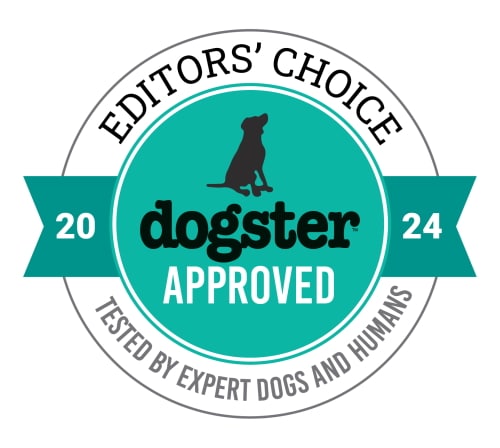Click to Skip Ahead
Your dog itches constantly. You wake up every night hearing your pup gnaw on his paws. You’ve heard of food allergies, so you swap the food around to no avail. You bring this concern up at your next veterinary appointment to your veterinarian. They suggest an elimination diet trial. What is that? Here’s what you need to know about elimination diets.
How Does an Elimination Diet Work?
First, you need to know what we’re trying to rule out with an elimination diet: a food allergy. Dogs typically produce an immune response to the protein in a food, although carbohydrates could be involved in a smaller number of cases.
Your veterinarian will likely suggest a specific food for your dog’s elimination trial, where we utilize a protein source your dog hasn’t had before. You’ll want to think of everything your dog eats so your veterinarian can pick a novel protein diet.
You will need to feed the prescribed food—and no other foods—for a set period. Tufts University suggests performing the feeding trials for at least 8 to 12 weeks.1
What Are the Different Types of Elimination Diets?
There are two main categories for elimination diets: novel protein diets and hydrolyzed diets
Novel protein diets feature a protein source that dogs generally have not eaten before. In the United States, these may include the following:
- Kangaroo
- Duck
- Rabbit
- Alligator
- Venison
- Royal Canin Veterinary Diet Adult Selected Protein PR (potato and rabbit)
- Royal Canin Veterinary Diet Adult Selected Protein PW (potato and whitefish)
- Hill’s Prescription d/d (potato and venison)
- Hill’s Prescription d/d (potato and salmon)
- Blue Buffalo Natural Veterinary Diet NP Novel Protein Alligator
Keep in mind that what is novel for one dog might not be novel for another. Maybe you’ve fed your dog venison before. In that case, it’s not a novel protein for your dog. In some cases, there may be cross-reactivity between proteins. For example, dogs that are allergic to chicken may also react to turkey proteins, which may not be an effective diet option.
Hydrolyzed protein diets utilize molecules broken down into much smaller components. As such, dogs are less likely to react to these molecules. The protein source is often less important with these diets, so a dog allergic to chicken could still safely consume a diet made with hydrolyzed chicken.

Where Is an Elimination Diet Used?
A diet trial or an elimination diet challenge is used to help identify food allergies. Typically, dogs manifest food allergies with skin issues like recurrent ear infections or licking their paws constantly or with gastrointestinal signs like chronic diarrhea.
With an elimination diet, you feed only one food for a set period, typically at least two months. Do not give anything else that might have protein in it, such as toothpaste or heartworm prevention with flavoring.
Diet trials are necessary because, unlike allergy testing for pollen and dust mites, allergy testing isn’t very effective for food allergies in dogs.
If your dog’s signs clear up on the diet, you’ll need to perform a challenge. You can slowly add one food at a time to see if signs come back. If they do, your dog is likely allergic to that particular protein source.
Advantages of an Elimination Diet for Dogs
- Helps to identify your dog’s food allergies
- It can save you money in the long term
- Keeps your dog more comfortable with less allergy signs
An elimination diet trial is critical to assess dogs for food allergies. By completing the trial, you can learn what foods are safe for your dog to eat, potentially significantly reducing the frequency of allergy signs.
In addition to making your dog more comfortable, performing a food trial could save you money in the long run. By eliminating food allergens from your dog’s diet, you might be able to avoid expensive trips to the dermatologist for chronic skin issues like pyoderma or otitis externa (a classification of ear infection).
Disadvantages of an Elimination Diet for Dogs
- The food for the trial can be expensive
- It takes time
- Picky eaters might not like the taste of hydrolyzed protein foods
- Everyone around your dog has to be aware and avoid giving them other foods
Food for a diet trial can be expensive, and prescription diets are typically much more effective than over-the-counter novel protein foods.
Elimination diets take time. First, you’re feeding a specific food for at least two months, sometimes longer, before challenging the diet. Then, you’re supposed to challenge each food your dog has eaten to find what they’re allergic to. (Some people skip this step and continue to feed the novel protein or hydrolyzed protein diet long-term.)
Hydrolyzed protein diets are not always as palatable as other food options, so your dog might not want to eat the food.
Elimination diets also involve some detective work on your part. You’ll need to list everything you’ve given your dog so that your vet can find a diet that is least likely to cause a reaction.
The other tricky part of a food trial is that everyone with access to your dog needs to be on board. You might not be giving treats, but are your kids or neighbors?

Frequently Asked Questions (FAQ)
What is the most common food allergy in dogs?
According to the veterinary dermatologists at Veterinary Skin and Ear in California, beef is the most common food allergy in dogs, followed by dairy and chicken.
Can I cook for my dog on an elimination diet?
If you prepare home-cooked meals for your canine family member, you’ll need to ensure the recipe is balanced. Consult with a veterinary nutritionist to ensure the foods are novel and the recipe meets all nutrient requirements.
If you need to speak with a vet but can’t get to one, head over to PangoVet. It’s an online service where you can talk to a vet online and get the personalized advice you need for your pet — all at an affordable price!

There are some advantages to utilizing a home-cooked meal for your dog. While it can be much more time-consuming, ultimately, you’ll know exactly what is in your dog’s food. Many dogs find these diets very palatable, unlike hydrolyzed protein diets, which may be a bit less palatable. Many veterinarians also recognize that cooking for your dog helps strengthen and foster the human-animal bond.
Conclusion
Food elimination trials can be challenging for pet owners. They tend to be pricey, and you need to make sure everyone in the household is following along to make sure your dog doesn’t get any extra snacks. They can help you understand your dog’s allergies and are often a very valuable tool.
Featured Image Credit: Prostock-studio, Shutterstock












